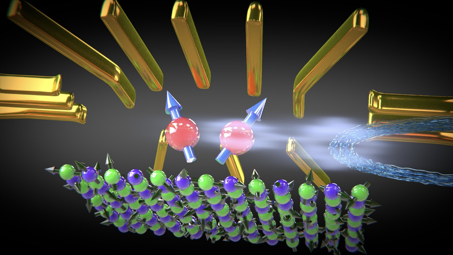Date:
Mon, 25/11/201912:00-13:30

Location:
Levin building, Lecture Hall No. 8
Lecturer:
D. M. Zumbühl, Department of Physics, University of Basel, Switzerland
Lecturer: D. M. Zumbühl, Department of Physics, University of Basel, Switzerland
Abstract:
Semiconductor spins confined in quantum dots are among the leading candidates for scalable quantum computing because they are small and fast, potentially allowing for the integration of millions of qubits. Here, I will present recent experiments exploring the fundamental physics of spins in GaAs gate defined quantum dots, with an outlook to nuclear spin free materials. Lower temperatures and control of the B-field direction have made it possible to observe hyperfine-phonon spin relaxation, obtaining relaxation times as long as 57 +/- 15 s – a record for a spin in a nanostructure [1]. Based on a model of the orbitals [2] and spectroscopy as a function of magnitude and direction of in-plane B-fields, we extract the orbital orientation and the z-confinement in a non-invasive way and with sub-nm precision [3]. Finally, the anisotropy of the spin-splitting is observed and compared to recent theory [4], finding good agreement.
In a second part, I will present tunneling spectroscopy measurements using a quantum wire tunnel coupled to a GaAs 2D gas to probe position, momentum, wave function profiles and the quasiparticle velocities of the quantum Hall edge states. We observe interesting features such as Fermi level pinning, wire to edge state hybridization, exchange-enhanced spin splitting and signatures of edge state reconstruction [5]. This technique could also be applied to fractional quantum Hall states and edge states in topological insulators.
[1] Hyperfine-phonon spin relaxation in a single-electron GaAs quantum dot, L. C. Camenzind, L. Yu, P. Stano, J. Zimmermann, A. C. Gossard, D. Loss and DMZ, Nature Communications 9, 2454 (Aug 2018).
[2] Gate-defined quantum dot in a strong in-plane magnetic field: orbital effects P. Stano, C.-H. Hsu, L. C. Camenzind, L. Yu, DMZ and D. Loss, Phys. Rev. B99, 085308 (Feb 2019).
[3] Spectroscopy of Quantum-Dot Orbitals with In-Plane Magnetic Fields, L. C. Camenzind, L. Yu, P. Stano, J. Zimmermann, A. C. Gossard, D. Loss and DMZ, Phys. Rev. Letters 112, 207701 (May 2019).
[4] Gate-defined quantum dot in a strong in-plane magnetic field: spin-orbit and g-factor effects, P. Stano, C.-H. Hsu, M. Serina, L. C. Camenzind, DMZ, D. Loss, Phys. Rev. B98, 195314 (Nov 2018).
[5] Evolution of the quantum Hall bulk spectrum into chiral edge states, T. Patlatiuk, C.P. Scheller, D. Hill, Y. Tserkovnyak, G. Barak, A. Yacoby, L. N. Pfeiffer, K. W. West, and DMZ, Nature Comm. 9, 3692 (Sep 2018).
Abstract:
Semiconductor spins confined in quantum dots are among the leading candidates for scalable quantum computing because they are small and fast, potentially allowing for the integration of millions of qubits. Here, I will present recent experiments exploring the fundamental physics of spins in GaAs gate defined quantum dots, with an outlook to nuclear spin free materials. Lower temperatures and control of the B-field direction have made it possible to observe hyperfine-phonon spin relaxation, obtaining relaxation times as long as 57 +/- 15 s – a record for a spin in a nanostructure [1]. Based on a model of the orbitals [2] and spectroscopy as a function of magnitude and direction of in-plane B-fields, we extract the orbital orientation and the z-confinement in a non-invasive way and with sub-nm precision [3]. Finally, the anisotropy of the spin-splitting is observed and compared to recent theory [4], finding good agreement.
In a second part, I will present tunneling spectroscopy measurements using a quantum wire tunnel coupled to a GaAs 2D gas to probe position, momentum, wave function profiles and the quasiparticle velocities of the quantum Hall edge states. We observe interesting features such as Fermi level pinning, wire to edge state hybridization, exchange-enhanced spin splitting and signatures of edge state reconstruction [5]. This technique could also be applied to fractional quantum Hall states and edge states in topological insulators.
[1] Hyperfine-phonon spin relaxation in a single-electron GaAs quantum dot, L. C. Camenzind, L. Yu, P. Stano, J. Zimmermann, A. C. Gossard, D. Loss and DMZ, Nature Communications 9, 2454 (Aug 2018).
[2] Gate-defined quantum dot in a strong in-plane magnetic field: orbital effects P. Stano, C.-H. Hsu, L. C. Camenzind, L. Yu, DMZ and D. Loss, Phys. Rev. B99, 085308 (Feb 2019).
[3] Spectroscopy of Quantum-Dot Orbitals with In-Plane Magnetic Fields, L. C. Camenzind, L. Yu, P. Stano, J. Zimmermann, A. C. Gossard, D. Loss and DMZ, Phys. Rev. Letters 112, 207701 (May 2019).
[4] Gate-defined quantum dot in a strong in-plane magnetic field: spin-orbit and g-factor effects, P. Stano, C.-H. Hsu, M. Serina, L. C. Camenzind, DMZ, D. Loss, Phys. Rev. B98, 195314 (Nov 2018).
[5] Evolution of the quantum Hall bulk spectrum into chiral edge states, T. Patlatiuk, C.P. Scheller, D. Hill, Y. Tserkovnyak, G. Barak, A. Yacoby, L. N. Pfeiffer, K. W. West, and DMZ, Nature Comm. 9, 3692 (Sep 2018).
